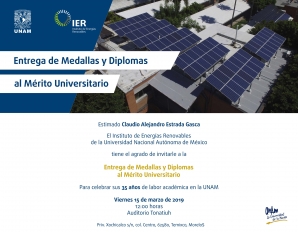Mostrando artículos por etiqueta: 2014 publication
Test of turbulence models for natural convection in an open cubic tilted cavity
V. H. Benítez Baltazar, J. H. Pacheco Ramírez, N. Pitalúa Díaz.
Abstract
A comparison was made between six turbulence models and experimental temperature profiles for the turbulent natural convection in a tilted open cubic cavity. The experimental setup consists of a cubic cavity of 1 m by side with one vertical wall receiving a constant and uniform heat flux, whereas the remaining walls are thermally insulated. The thermal fluid is air and the aperture is facing the heated wall. The temperature profiles were obtained at different heights and depths and each one consists of 10 positions inside the cavity. A commercial computational fluid dynamic software was used for the simulation and different turbulence models of k-εt and k-ω families were evaluated against experimental data. The lowest absolute average percentage difference for the experimental and numerical temperature profiles was for the rk-εt model and the highest was for the sk-ω model.
Test of turbulence models for natural convection in an open cubic tilted cavity
Heliostat image drift behavior for different error sources
Martha Escobar-Toledo, Camilo A. Arancibia-Bulnes, Cuitlahuac Iriarte-Cornejo, Julio Waissman, David Riveros-Rosas , Rafael E. Cabanillas and Claudio A. Estrada.
Abstract
Drift is ubiquitous in heliostat fields, and may be caused by diverse geometrical inaccuracies during heliostat installation and operation. This phenomenon is studied for three important primary errors in the present paper: Angular offset in the drive mechanism, pedestal tilt, and canting error. Each error produces characteristic signatures, but there is a diversity of behavior depending on the error parameters and location of the heliostat. The variation of the extent of drift curves is studied as a function of distance, for fixed error parameters. It is found that, in general, this extent is not proportional to distance, except for far heliostats, and depends on a complicated manner on the different parameters involved. Moreover, even though the extent of drift curves becomes proportional to distance for far heliostats, the convergence is very slow, and very variable with the error parameters.
Compensation of heliostat drift by seasonal sampling
C. Iriarte-Cornejo, C.A. Arancibia-Bulnes, I. Salgado-Transito, J. Waissman, R.E. Cabanillas, C.A. Estrada.
Abstract
Heliostat image drift is a common phenomenon in central receiver solar power plants. Several geometrical errors produce drift of the heliostat solar spot at receiver surface, increasing radiation spillage. A heuristic drift compensation method is proposed, based on a polynomial approximation to the drift trajectories. Results of the practical implementation of the proposed method for the control of 10 heliostats in a solar tower facility are presented. A substantial improvement of heliostat tracking is observed on the experimental tests. Because heliostat drift experimental monitoring is a time consuming task, a numerical analysis of the yearly behavior of the compensation method, based on simulations of heliostat drift, was carried out. In these simulations, the behavior of the daily RMS deviation of the concentrated solar spot centroid is evaluated for a whole year, as the polynomial correction is applied. The simulations serve also to test the effectiveness of the proposal polynomial method in a wider range of conditions. Thus, heliostats with a variety of primary error values are simulated. Random wind induced vibrations are introduced in the simulation to evaluate the effectiveness of the calibration method under noise conditions. It is found that a very effective calibration can be achieved with a few sampling events of the heliostat behavior during the year, taking only a few minutes. The RMS deviation can be reduced to values of the order of the wind induced noise level. The proposed polynomial compensation looks like a promising alternative to be implemented in heliostat fields.Improving parabolic trough mirror module qualification by FOCuS tool
Manuel I. Peña-Cruz, Camilo A. Arancibia-Bulnes, Ana Monreal Vidal, and Marcelino Sánchez González.
Abstract
An improved tool for the shape qualification of parabolic trough mirror modules used in concentrated solar power plants was developed. The tool is based on the fringe reflection theory, in which sinusoidal fringe patterns are projected on a screen and their reflection over a specular surface is recorded by a camera. The observed distortions in the image are related directly to surface deviations from ideal geometry. Relevant aspects of the technique are its high spatial resolution (more than 1 × 106 points per mirror facet), short measurement time and easy setup. The developed tool (called FOCuS) is capable of calculating the local mirror slope deviations from its ideal design and the RMS value as a quality factor. Furthermore, the tool generates a file which can be loaded into CENER's TONATIUH ray tracing software, through a specially developed plug-in, for mirror modeling and intercept factor calculation with several tube absorber geometries.
Improving parabolic trough mirror module qualification by FOCuS tool

